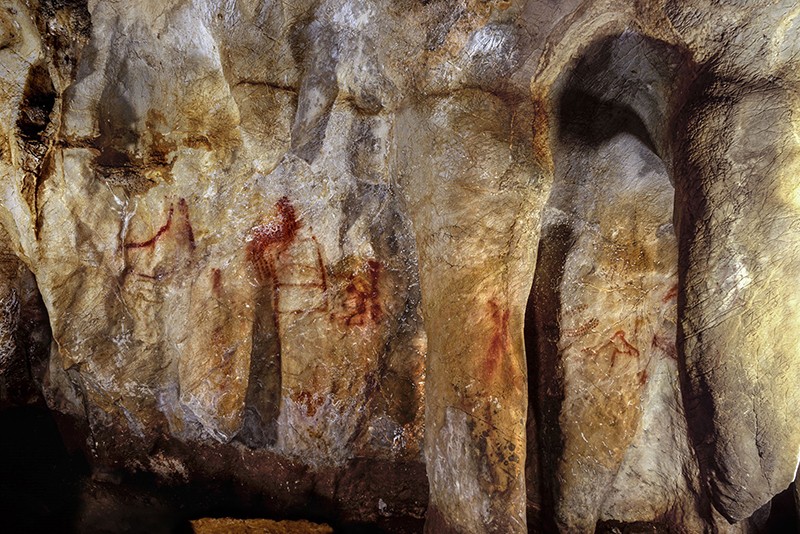Neanderthal artists made oldest-known cave paintings
Neanderthals painted caves in what is now Spain before their cousins, Homo sapiens, even arrived in Europe, according to research published today in Science1.
The finding suggests that the extinct hominids, once assumed to be
intellectually inferior to humans, may have been artists with complex
beliefs.
Ladder-like shapes, dots and handprints were painted and
stenciled deep in caves at three sites in Spain. Their precise meaning
may forever be unknowable, says Alistair Pike, an archaeologist at the
University of Southampton, UK, who co-authored the study, but they were
almost certainly meaningful to our lost kin. “It wasn’t simply
decorating your living space,” Pike says. “People were making journeys
into the darkness.”
Humans are thought to have arrived in Europe
from Africa around 40,000–45,000 years ago. The three caves in different
parts of Spain yielded artworks that are at least 65,000 years old,
according to uranium-thorium dating of calcium carbonate that had formed
on top of the art.
These mineral deposits develop slowly, as
water containing calcium comes into contact with cave surfaces. The
water also contains trace levels of uranium from the rock. After the
calcium carbonate has precipitated out of the water, a clock of sorts
begins to tick, as uranium decays into thorium at a steady, known rate.
A datação por urânio-tório tem sido usada na geologia há décadas, mas raramente foi empregada para estimar a idade da arte rupestre. Alguns arqueólogos são céticos quanto à abordagem. Eles sugerem que o carbonato de cálcio poderia ter se dissolvido e se cristalizou novamente depois que foi formado - um processo que também poderia ter lavado algum urânio, fazendo com que uma amostra do mineral aparecesse mais velha do que é.
Até agora, a mais antiga arte rupestre conhecida era de aproximadamente 40.000 anos
— stenciled hands and animals in an Indonesian site2 that was dated in 2014, and discs and hand stencils from a cave in Cantabria, Spain3, that were found by Pike and his colleagues in 2012.
Drawing conclusions
Anticipating
objections about its dating method, Pike’s team collected samples from
the outer, middle and inner layers of the calcium carbonate crust and
dated them separately. As they expected, the inner samples closest to
the art yielded the oldest dates, and the outer samples had younger
dates because they would have been later layers of precipitate. “We
can’t think of any processes that would re-crystalize the calcite and
still keep them in stratigraphic order,” Pike says. The researchers
waited three years to publish their results after finding their first
clearly pre-human date so they could collect multiple examples and
publish their methodology.
Some archaeologists, however, remain unconvinced. “In my
opinion, we have to be cautious with these ‘quite old’ results until we
have a much larger corpus of dating results,” says Roberto Ontañón
Peredo, an archaeologist at the Prehistory and Archaeology Museum of
Cantabria in Santander, Spain. “We have to keep a cool head.”
Pike
suggests that such reluctance to believe that Neanderthals were
creating cave art may have less to do with methodological disputes than
plain old species-ism. “People are very prejudiced against
Neanderthals,” he says.
Paola Villa, an archaeologist who studies
Neanderthal culture at the University of Colorado Boulder, says that
Neanderthals have an undeserved reputation as moronic brutes. She says
that since their bodies were “archaic” in the sense of having features
of older hominids — such as heavier bones and pronounced brow ridges —
everyone assumed they were “behaviourally archaic” as well. “They were
stereotyped as knuckle-dragging dimwits,” she says.
This
assumption has fed into theories about their extinction, which have
tended to hinge on humans outcompeting slower, dumber Neanderthals. But
Villa says a careful review of the research shows “no support for a
cognitive gap between Neanderthals and modern humans”. Newer theories
instead focus on factors such as low population density and “assimilation by interbreeding” with humans.
The
ladder-like art Pike and his colleagues ascribe to Neanderthal artists
has, inside its rectangular forms, faint paintings of animals. These
remain a mystery, but Pike speculates that they might be the result of
“modern humans coming in and adding their own art”. Humans and
Neanderthals may have thought alike, interbred and even — in a way —
collaborated artistically, he says.

Nenhum comentário:
Postar um comentário
Observação: somente um membro deste blog pode postar um comentário.